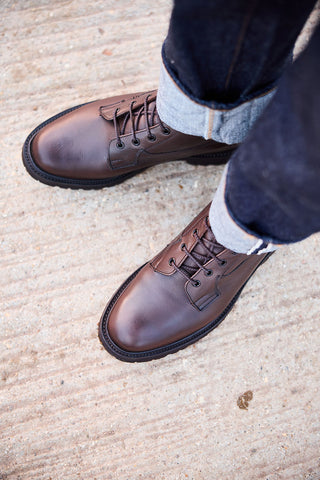Tricker’s have been making shoes since 1829. From those early beginnings, exacting standards in craftsmanship, unrivalled attention to detail and the use of only the highest quality materials have resulted in the unique reputation that Tricker’s enjoys today
Goodyear Welt Construction is the process that separates high quality Northampton footwear from eponymous disposable footwear. Though expensive, time-consuming, and difficult to master, our Goodyear Welt Construction creates tightly-crafted footwear that is water-resistant and wearable for years to come. It’s a build quality that combines centuries of human ingenuity with skilled craftsmanship

Welted construction gives our footwear its strength and durability by stitching the upper leather, lining leather and welt to the ribbing that has already been bonded to the insole. The welt is then stitched to the leather or rubber sole. It is this final stitch process by holding the sole in place, that allows a complete removal of the sole without causing any damage to the upper
The welt is a leather strip that joins insole to upper to which the sole is subsequently attached by stitching. Because welted shoes are sewn together rather than glued, a skilled craftsman can dismantle, repair, and refurbish them

Barbour Welt
Tricker’s has always been highly responsive of market trends, evolving and being innovative. It was one of the first Northampton companies to bring the Goodyear welting machines over from America, this machine was able to stitch together the welt, upper, and soles, without hand-sewing.

Charles W Goodyear (1846 –1911)
Charles Goodyear Jr. was a member of the prominent Goodyear family of New York. In 1871, Goodyear Jr, who wielded the finances of his famous father’s estate, purchased an 1869 patent from a New York shoe producer named James Hanan for a modified sewing machine that used a curved needle and awl to sew welts onto shoes without taking them off the last or penetrating the insole.
This new machine offered considerable advantages over the previously popular McKay (Blake stitch machine) method but was riddled with mechanical difficulties.
Upon purchasing the patent, Goodyear hired its original inventor Auguste Destouy and another mechanic named Daniel Mills to work for him at the American Shoe Tip Company and sort out the new machine’s shortcomings.
Under Goodyear’s direction and, more importantly, with his financial support the two got to work and this effort resulted in the famous 1875 patent for the welting machine that would take on Goodyear’s name

Early Goodyear Welting Machine
This machine made it possible to sew the shoes upper with the insole, without having to attach the undersole with the same stitching. In other words, you could make a smart, well-made shoe with the help of a machine, and not only by hand which had long been practised by Tricker's since 1829.
Manufacturers from Northampton streamed across the Atlantic to learn the new method, and the welted construction is to this day still being practiced at Tricker's



